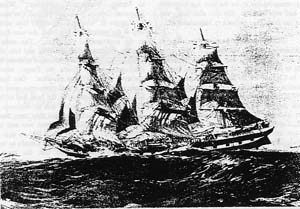 |
FAMOUS SHIPS |
 |
FAMOUS SHIPS |
FAMOUS SHIP "'THE DUNTRUNE"
The DUATRUNE was among the finest and fastest iron clippers, which took emigrants to Australia and New Zealand in the 1870's and 1880's. She was 1,500 tons and belonged to David Bruce's Dundee Clipper Line. She carried passengers of the sturdy Scottish and North County stock at exceptionally low rates - 5 pounds steerage and 15 pounds second cabin.
An example of a voyage was started on Saturday, September 1, 1883. There were 448 emigrants, including women and children. All emigrants were berthed in the tween-decks, the single men forward, married couples and children amidships and the single women aft, each class being kept strictly apart. The crew, including Captain J. Rollo, numbered 49.
She was towed to Aberdeen, then had light winds and did not gain the Atlantic Ocean until Thursday. She had trouble with the fresh water condensing plant, which finally broke down. Since the water in the tanks also proved none too good, Captain Rollo put in to Madeira
on September 28 after a rough passage. Here the condenser was patched up. This delay spoiled the first passage. Since there were many sick children on board by this time, Captain Rollo took his time in the "roaring forties". The DUATRUNE.arrived in Moreton Bay on Christmas Day, and anchored off Brisbane three days later. She discharged her emigrants, went down to Newcastle, and loaded coal fbr San Francisco. She made the run across in 68 days.
At San Francisco she loaded-a grain cargo and sailed on July 2d, 1884. She arrived off Roches Point on November 3d, 124 days out and at Havre, her port of discharge, on November 9th. She was launched in May 1875, from the Dundee slips of Alexander Stephen & Sons. She was as sharp as a knife below the water line forward and anticipated the bow entrance of a modem destroyer. Her stem was almost square, but she had very fine lines.
She was a very fine sea boat, being able to keep her decks dry in the
"roaring forties", an unusual feature for an iron
clipper. She steered very easily and a lee wheel was never needed. It was rare
that anything heavier than the tops of seas ever come aboard, and sailors who
had been a lifetime at sea pronounced her to be the best sea boat that they had
ever been in. She was also fast - she had a run from Port Augusta to Valparaiso
of 31 days. 
During her early years she was kept in the Australian trade. Her-first few years were none too spectacular, but this was probably owing to her captains. In 1891 she was handed over to Captain J.C.B. Jarvis, who had a great reputation. Under his command the DUNTRUNE became a crack ship. As a result of this skipper, the ship became noted for her smart passages as well as becoming a "happy ship". Captain Jarvis was a stem disciplinarian, but was also just and infinitely kind. He was never known to loss his temper. He was also well over six feet in height. He picked his officers and crew carefully and expected that all would do what they had to do. He saw to it that all his crewmembers had the best of care and food while on his ship, which was rare in his day. Captain Jarvis was also an inventor of kinds, having "gadgets" made to make sailing the ship easier. He was remembered for his brace winches. The next several voyages were good to excellent. One passage was ruined due to DUNTRUNE running into an iceberg. She was seen too late to avoid entirely, and there was a sickening crash as she went by the berg. Everything up forward was suddenly piled high with ice, but apparently the sturdy DUNTRUNE had cut a comer clean off the iceberg and then gone clear. She was damaged and her foretopmast came down, but she made it to the Equator, then 27 days to Plymouth.
She made an excellent run to Melbourne of 76 days, although with a little luck it could have been much better, since she had went from Gravesend to the Line in only 19 days. On his last outward passage 'in the DUATRUNE, Captain Jarvis made one of the finest passages ever known between the Thames and the Columbia River, the vessel being only 106 days out when she arrived off the Bar, having come up the Pacific from the Hom in the extraordinary time of 41 days.
In 1896 Messrs. David Bruce & Co. decided to sell all their sailing ships, the DUNTRUNE going to Messrs. Woodside, of Belfast. When this happened Captain Jarvis left her and was succeeded by Captain G. Winterton. Tragedy then struck the ship in the autumn of 1899 when she was dismasted to the westward of the Hom. The same night Captain Winterton died, his wife and two children being on board. They managed to make land on the west coast of Tierra del Fuego, where she anchored in 45 fathoms of water. One boat was repaired and carpenter and seven men went to find help. They became lost in the boat and drifted for 17 days, three men dying due to exposure. The survivors were picked up and they were landed at Sandy Point. A Chilean gunboat was sent to look for the DUATRUNE, but could find no sign of her and she was eventually posted at Lloyd’s as missing. It is generally concluded that she must have foundered soon after the carpenter's boat had left her side and all aboard were lost.